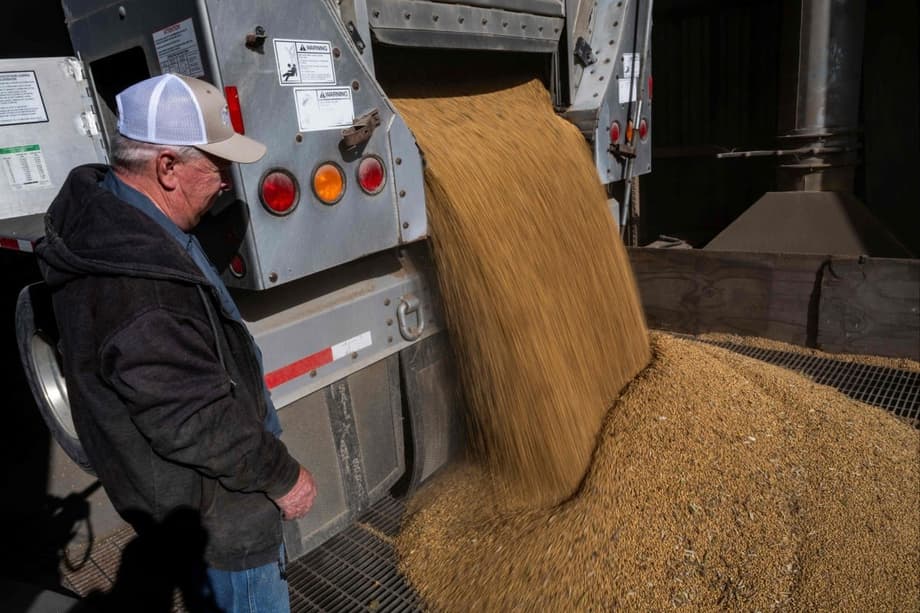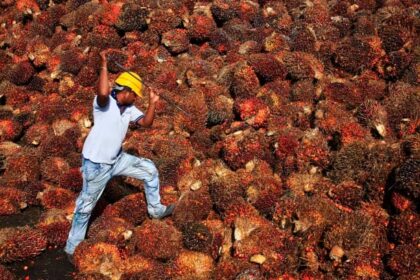September data shows a sharp turn in soybean trade
China imported no soybeans from the United States in September for the first time since November 2018, even as total arrivals reached 12.87 million metric tons, the second highest monthly level on record. Shipments from Brazil rose to about 10.96 million tons, roughly 85 percent of the total, while deliveries from Argentina climbed to around 1.17 million tons, near 9 percent. The absence of US cargoes came as tariffs and a stalled negotiating track kept Chinese buyers focused on South American supply during the peak of the American harvest.
- September data shows a sharp turn in soybean trade
- Why China is turning to South America
- Brazil strengthens its lead
- Argentina and Uruguay step in
- US farmers face a shrinking window
- Will China face a supply pinch before new Brazilian crops
- Food security, feed reform, and domestic goals
- Environmental and sustainability pressures
- What to watch in trade talks and markets
- Key Points
Compared with a year earlier, China’s September soybean imports increased about 13 percent and were up about 5 percent from August, according to customs figures. The world’s largest soybean buyer continues to rely on the crop to feed its hog and poultry herds and to produce edible oil. With talks uncertain and tariffs in place, Chinese crushers and state companies have bolstered risk management by diversifying purchase sources and securing large volumes from Brazil and, to a lesser degree, Argentina.
Several short term factors reinforced the shift. Brazil harvested a large crop earlier in the year, which kept prices competitive into late summer. An Argentine tax holiday on exports created a brief window for discounted beans. Traders also reported that previously harvested US supplies, known as old crop beans, had already moved, thinning the flow of cargoes that sometimes bridge the gap before new harvest shipments accelerate.
Analysts in Beijing say policy barriers remain the decisive driver behind the September pause in US arrivals. In the view of Wan Chengzhi, an analyst at Capital Jingdu Futures in Beijing, the tariff structure is the central reason behind the abrupt halt in US shipments.
“This is mainly due to tariffs. In a typical year some old crop beans would still enter the market.”
Chinese buyers have not booked any cargoes from the new US harvest for fourth quarter shipment. The traditional purchase window for US soybeans, usually September through January before Brazil’s new crop hits ports, is being shortened as buyers lock in South American shipments through November.
Why China is turning to South America
Price, timing, and policy together explain the current bias toward South America. Brazil’s bumper crop earlier this year swelled stocks and pressured export prices. The Brazilian real has been relatively soft, which can improve dollar denominated competitiveness for Chinese buyers. Freight from Brazil’s northern ports has become more efficient and competitive. For importers seeking predictable flows, these conditions have made Brazil the default supplier for much of 2025.
Tariffs and timing shape the trade
China typically leans on US soybeans during the early months of the American marketing year. This year, however, traders in Brazil estimate that Chinese firms locked in roughly 8 million tons for September and near 4 million tons for October from South American sellers. Those volumes cover about half of projected demand for the two months and crowd out US bids during a stretch that is normally a prime period for American farmers. Chicago soybean futures have hovered near five year lows as the market prices in reduced Chinese buying.
Over several years, the structure of China’s import mix has also shifted. The US share of China’s agricultural imports fell to near 12 percent in 2024 from about 20 percent in 2016, while Brazil’s share rose to around 22 percent. More South American suppliers, including Argentina and Uruguay, mean China can satisfy demand while reducing exposure to a single seller in a politically tense relationship.
Brazil strengthens its lead
In August, China brought in about 12.2 million tons of soybeans, with 10.49 million from Brazil, more than 85 percent of the total. September continued that pattern at even higher volumes. Brazil has been the world’s top soybean exporter for most of the last decade. In 2023 it shipped a record crop and moved more than half of global exports. Studies that track the last two decades show Brazil’s exports rising more than fourfold, with roughly seven out of every ten Brazilian export bushels headed to China in recent years.
Brazil’s advantage is built on scale, new acreage in frontier regions, and upgrades to ports and river corridors. Exporters have expanded loading capacity at Santos, Paranagua, and northern arc terminals on the Amazon corridor. Chinese commodity firms and financial institutions have participated in logistics investments and long term supply agreements, which reduce uncertainty for Chinese crushers when demand is strong.
Even with a smaller Brazilian crop expected in the current season, projections still place Brazil’s share of global soybean exports above 50 percent. Competitive prices and a steady logistics pipeline keep Brazil at the center of China’s procurement strategy.
Argentina and Uruguay step in
Argentina, typically a powerhouse in processed soybean meal and oil, shipped more whole beans to China in September as domestic supplies improved and a brief suspension of export taxes made sales attractive. China’s arrivals from Argentina rose about 91 percent year on year to roughly 1.17 million tons.
Uruguay, a smaller producer, has become a useful supplemental origin. Its 2024 to 2025 harvest reached about 4.2 million tons, up from the prior year. Trade sources count 2.43 million tons already booked from Argentina and Uruguay for shipment between September and May, and they estimate Chinese processors could buy up to 10 million tons from the two countries combined in the 2025 to 2026 marketing year if prices stay favorable.
From September 2024 through July 2025, China imported close to 5 million tons from Argentina and Uruguay combined, according to customs tallies. The additional flow tightens the gap left by zero US arrivals and gives crushers more flexibility to manage margins.
What the surge means for prices and crushers
A wave of South American beans typically softens global prices, which improves crushing margins for Chinese plants that turn soybeans into meal for feed and oil for cooking. Stronger margins can encourage higher operating rates, which supports steady feed supply for a still large hog herd despite recent cycles of contraction and rebuilding.
US farmers face a shrinking window
China imported about 105 million tons of soybeans last year, with roughly 22.13 million from the United States. Much of that US volume is usually sold during the autumn window before Brazil’s new harvest crowds the market. By moving early to secure South American beans in September and October, Chinese buyers have compressed the traditional shipping window for American exporters.
Farm incomes are sensitive to that timing. Elevators and farmers in the Midwest plan storage and sales around expected export flows to China in the early part of the marketing year. With Chinese demand sidelined, basis levels weaken and futures remain under pressure. Many growers face difficult choices on whether to store beans or sell into a soft market.
America is processing more at home
Some of the lost export demand is being absorbed by rapid growth in US crushing capacity. Driven by renewable diesel targets and investment in processing plants, US demand for soybean oil has increased since 2021. That encourages more domestic crushing and a larger supply of soybean meal for livestock sectors in North America. Analysts expect the US share of global soybean exports to remain below 30 percent in the 2024 to 2025 cycle, well under the near 40 percent share that prevailed a decade ago. The United States is diversifying export outlets as well, finding growth in Mexico, Egypt, Japan, and parts of Southeast Asia.
Will China face a supply pinch before new Brazilian crops
Despite heavy arrivals in late summer and autumn, China’s inventory pace will be tested early next year. If Brazilian loadings slow or if stocks prove tighter than expected, Chinese crushers could face a short window of tight supply between February and April before the next Brazilian crop ships in volume.
Johnny Xiang, the founder of the consultancy AgRadar in Beijing, cautions that tightness is possible if trade talks fail to unlock fresh supply.
“A soybean supply gap may emerge in China between February and April if there is no trade deal. Brazil has shipped a huge volume, and the size of old crop stocks is uncertain.”
In that scenario, China could tap reserve stocks, tweak soymeal inclusion rates in feed formulas, or make targeted spot purchases from the United States if prices and politics allow. Weather, freight, and the pace of the Brazilian harvest will be critical variables.
Food security, feed reform, and domestic goals
Beijing sees heavy soybean import dependence as a weak point in food security. Policy documents in the current Five Year Agricultural Plan place greater emphasis on self sufficiency in grains and oilseeds, including soybeans. Authorities have expanded incentives for domestic soybean cultivation and promoted crop rotations in northeastern provinces. Land and water constraints, along with lower yields, limit how far domestic output can climb in the short run.
China is also trying to moderate demand growth by reforming animal feed. An action plan issued by the agriculture ministry aims to cut the share of soymeal in feed from about 14.5 percent to less than 13 percent by 2025. Feed mills are experimenting with rapeseed meal, peanut meal, and sunflower meal. If these changes stick, they could cap the pace of soybean import growth while still meeting protein needs in the livestock sector.
Several analysts argue that China’s soybean imports may have peaked in recent years because of these structural shifts and because hog production has normalized after disease outbreaks. Yet the gap between domestic output and consumption remains large. From January through September, cumulative soybean imports exceeded 85 million tons, underscoring how central foreign supply remains to the feed and oil system.
Environmental and sustainability pressures
The expansion of soy production in South America brings environmental scrutiny. Clearing in the Cerrado and pressure along Amazon corridors have raised alarms among regulators and global buyers. Major food companies and importers are tightening traceability and monitoring, and new rules in Europe restrict products tied to deforestation. Compliance adds cost but may drive investment in verified supply chains that can meet sustainability standards demanded by international customers.
Climate volatility also complicates planning. Argentina’s severe drought in 2022 to 2023 cut soybean output roughly in half, while parts of Brazil contend with alternating cycles of dry spells and heavy rain. Diversifying origins gives China options when weather hits a single producer, yet short term price swings and supply risks are hard to avoid.
What to watch in trade talks and markets
Officials from Beijing and Washington have been in contact in recent weeks, and meetings are planned. Any easing of tariffs or a purchase commitment could quickly change trade flows. Leaders in Washington have indicated that a resumption of Chinese buying would help unlock concessions on other topics, while Beijing has signaled it will calibrate purchases to suit domestic needs and diplomatic priorities.
Market participants will track Chicago futures, crush margins in China, the health of the hog herd, and the pace of South American loadings. A surprise round of US sales in late winter would signal that the supply gap is materializing. If Brazilian shipments continue at a heavy pace, South America will likely carry the bulk of China’s demand into the spring.
Key Points
- China imported 12.87 million metric tons of soybeans in September, the second highest on record, and bought zero from the United States.
- Brazil supplied about 10.96 million tons, near 85 percent of the total, while Argentina delivered roughly 1.17 million tons, near 9 percent.
- September arrivals were up about 13 percent year on year and 5 percent from August, sustaining historically high import levels.
- Tariffs led Chinese buyers to shun US cargoes, a view echoed by analyst Wan Chengzhi in Beijing.
- Chinese firms booked large early South American purchases for September and October, reducing the traditional US export window.
- Argentina’s brief export tax holiday spurred sales, and Uruguay’s larger crop added optionality; bookings from the two reached about 2.43 million tons for shipment through May.
- US farmers face weaker prices and a shorter sales window, although rising domestic crushing for renewable diesel is absorbing more beans.
- Analyst Johnny Xiang warns of a possible China supply gap in February to April if Brazil’s new crop is delayed and trade talks stall.
- China aims to lift domestic soybean output and lower soymeal inclusion in feed to below 13 percent by 2025, which could temper import growth.
- Brazil remains China’s primary supplier, supported by scale, logistics upgrades, and price competitiveness.












